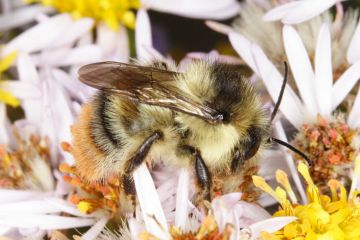Species Account for Bombus sylvarum
Bombus sylvarum (Linnaeus, 1761)
Shrill Carder Bee
Aculeata: Apinae: Apinae

Reproduction for study and non-profit use permitted, all other rights reserved.
Taxonomic group: honey bee and bumblebees (Aculeata: Apinae) - Countywide data
View time series maps for Bombus sylvarum
member log-on for taxon report
Status: Nb;Section 41 Priority Species
Essex BAP: Listed
Essex RDB: Listed
Threat: Essex Vulnerable
Images
upload a new image
Essex Red Data List comment
Nationally important populations in the East Thames Corridor, but highly threatened.
Species text
This bumblebee is a national BAP species on the basis of major declines across Britain, with only four or five remaining metapopulations in England and south Wales, and the East Thames Corridor region currently supports one of the most important remaining metapopulations in the UK. Bumblebee populations appear to operate at a landscape scale and it is probable that viable individual populations require minimum ranges of between ten to twenty sq. km of good matrix habitat within farmland (Edwards, 1998), and B. sylvarum seems to require much larger areas of good habitat than Brown-banded Carder Bee B. humilis. The distribution map here needs to be interpreted with the understanding that sites have been lost and many more are under huge development threats. The status of the Dengie population is unclear, but certainly exists within a highly fragmented and suboptimal habitat landscape.
Forage areas need to be considered separately for queens and workers. The queens require nectar resources early in the season after their long winter hibernation to build up their reserves. They then need pollen resources for stocking cells in newly established nests to enable the first workers to develop. Workers also require nectar and pollen resources both for their own sustenance and to stock the developing nest.
It appears that large areas of fairly tall, open flower-rich grasslands providing areas of abundant forage are required to support populations of Bombus sylvarum. As with the Brown-banded Carder Bee observations suggest that large patches of flowers are used more frequently and are much more important than widely distributed resources. Observations also indicate that the availability of suitable forage (nectar and pollen) sources throughout the whole season from May to September is crucial. These resources need to be provided by an abundance of specific key forage sources, all of which significantly have very long flowering seasons as well as long corolla tubes which correspond to the long tongues of the bumblebees. Important plant species used in early summer by queens include Fodder Vetch, Red Clover and Broad-leaved Everlasting-pea. Workers forage on a more restricted range of flowers than the Brown-banded Carder Bee, and in south Essex species such as bird's-foot trefoils Lotus spp. (but especially L. glaber), Red Clover, Black Horehound Ballota nigra and Red Bartsia Odondites verna are the main resources (Harvey, 2000b; Harvey, 2001a).
ReferencesHabitats
Recorded management for locations with Bombus sylvarum
Recorded substrate and hydrology for locations with Bombus sylvarum
Why not join the Club, register and add a new species page
Interpretation of distribution maps





















